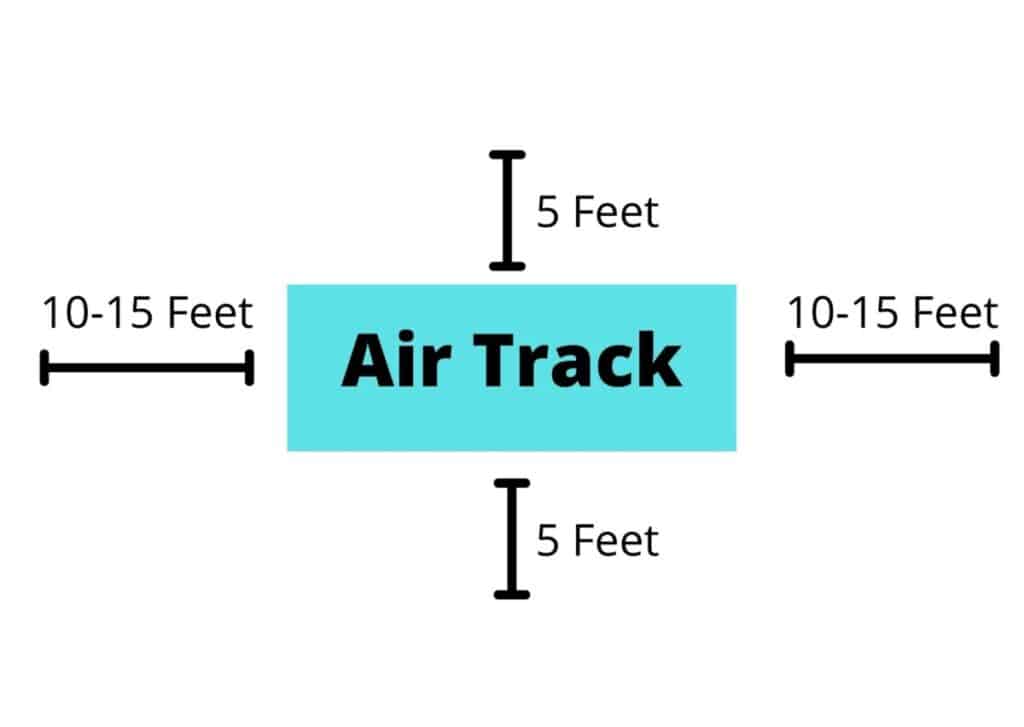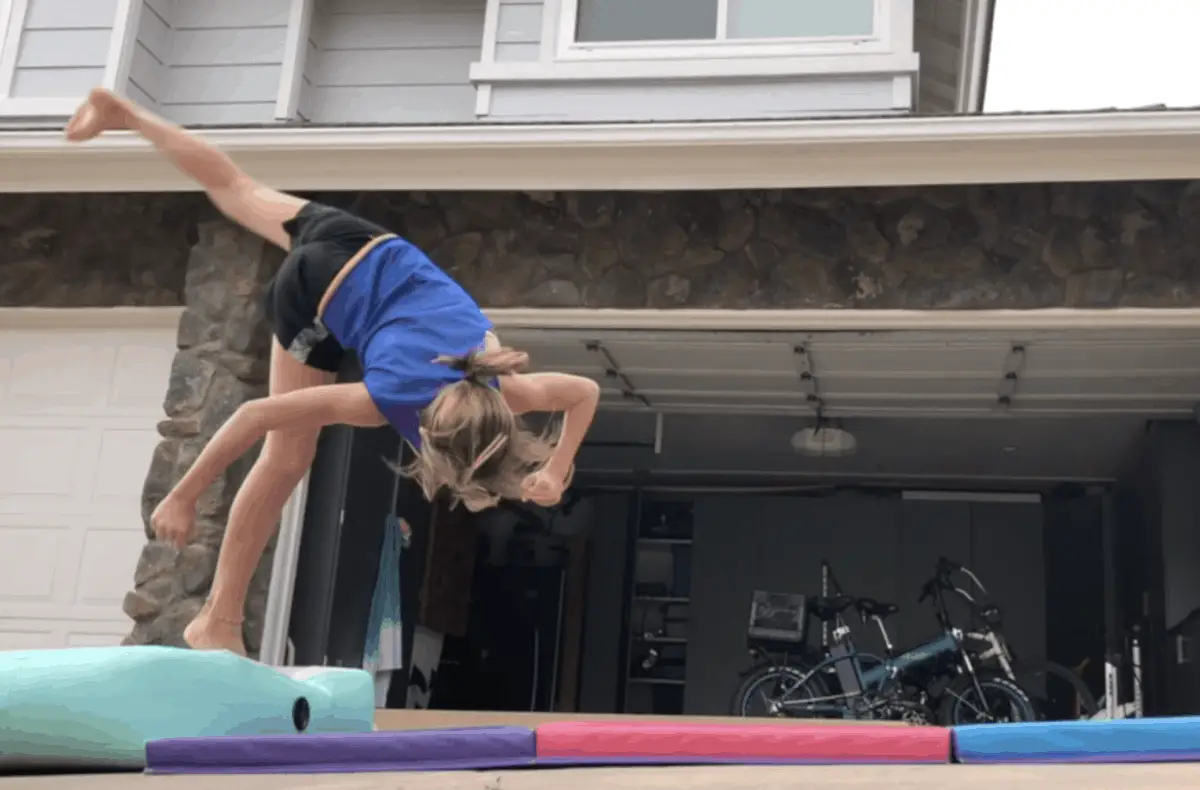Many parents are concerned about purchasing an air track for their gymnasts. The reality is there is some safety concerns about your child performing gymnastics at home without professional coaches. The air track is essentially a spring floor that allows gymnasts to attempt more advanced moves than a normal mat. In this article I’ll share 7 tips that will help keep your gymnast if you do decide to purchase an air track.
Here are 7 tips for air track safety in the home:
- Have adequate space on all sides of the air track
- Place the air track on a flat surface
- Place the air track on a soft surface
- Only attempt moves that are in your wheel house
- Be very careful when using the air track on water or snow
- Use an inflation level that is comfortable for you
- Always use the air track with a spotter or friend
If you have a gymnast an air track has or will be on there birthday list soon! They are incredibly fun and easy to use. They offer a great at home gymnastic outlet for you kids. That being said they can be dangerous. These 7 tips will keep you child safe while they use the air track at your house.
Tip 1 – Have Adequate Space On All Sides Of The Air Track
Before you purchase an air track do a survey of where you will be using it. You want to make sure you have adequate space on all sides of the inflatable.
The most common sizes of air tracks are 10, 16, & 20 feet. You will want at least 5 feet of space on the long sides of the air track and at least 10-15 feet of space on the short ends.
If your gymnasts performs a tumbling pass their momentum will carry them beyond the end of the track some times. There will also be occasions where your gymnast will fall off the side of the track and you’ll need space for them to land without crashing into something.
Knowing were you will be using the air track will help you decide the length of track you should purchase. The diagram below shows how how much space you’ll need as we discussed above.

Tip 2 – Place The Air Track On A Flat Surface
Your gymnast is used to performing all of their moves on a flat surface in the gym. Many neighborhoods are have slanted driveways and backyards to help with water flow away from the house when it rains. Even the flattest neighborhoods will have a slight decline away from the house.
This slight gradient doesn’t matter much when you are playing basketball or other sports in the yard. But when you are trying to an aerial, a back handspring or tumbling pass it can cause a gymnast to fall off balance.
Try your best to find the flattest area possible to set up the air track. They are relatively easy to move so even a young gymnast with a friend can carry the air track a good distance.
Tip 3 – Place The Air Track On A Soft Surface
When evaluating where you’ll be using your air track take into consideration the type of ground it’ll be place on. Grass is the preferred option for an air track. Sand also works pretty well if you happen to have a large area of sand nearby.
We’ve always put a tarp under the air track to protect it from getting punctured by sharp rocks, small sticks and twigs. Large blankets will also do the trick.
I would avoid placing the air track on your driveway or street if at all possible. There is little room for error in this situation and it could lead to injury.
You want to have a soft surface surrounding the air track in case your child falls off while performing a movement. You can imagine following off onto concrete feels a lot different than falling onto grass or sand.
Tip 4 – Only Attempt Moves That Are In Your Wheelhouse
Before giving your child the green light to use the air track it’s important to set some ground rules. Go over the moves they’ve been working on in gymnastics and decide which moves are appropriate and which moves are off limits.
As an example your daughter might have just learned how to do an aerial for the first time at practice. She’s can do it but still struggles to land that move consistently. This is a move she’s probably not ready to perform at home without a spotter or professional supervision.
On the other hand say she’s been doing back handsprings for over a year and can do one in her sleep. This is a move she can probably perform on the air track easily and not have any issues with falling off line and slipping off the inflatable.
Just make a list of moves are approved and ones that aren’t and your gymnasts experience on the air track will be safer.
Tip 5 – Be Careful When Using The Air Track On Water & Snow
It is becoming more and more popular for people to take their air tracks on. vacation with them. You’ll see images of air tracks set up off of boats that are on lakes, at the beach or even in the snow.
Their are even small circular air tracks known as an air spot which can be used for sledding. Not sure how long it’ll last as a sled but none the less people are definitely using them in this fashion.
If you do plan on taking your air track to one of these locales be sure to take some extra precautions. The obvious element here is the introduction of water to the air track. The air track will become very slick and your simple movements will become more difficult. Scale down the types of move you do as the air track becomes slippery.
If you are on a body of water be sure to check out the depth of the water before jumping off. There could be rocks or reef just below the surface.
If you take it to the snow recognize that you will have additional gear on and it will make doing most of your gymnastics moves very difficult.
Tip 6 – Use An Inflation Level That Is Comfortable For You
One of the great things about air tracks is how fast you can pump them up and deflate them. They are easy to store once they are deflated.
Inflating the air track to the correct level can help your experience be safer. If you pump it up and you are getting some serious air and find yourself a little out of control with simple moves you’ll want to adjust the air pressure to a more comfortable level.
Some air tracks are inflated by means of the supplied blower that lets you blow the mat up to any desired pressure. The mat comes with a pressure gauge. The pressure gauge accurately measures the pressure inside the track. The proper pressure is important for the correct use of the mat.
The pressure gauge is connected to the second valve of the track when the mat is inflated.
Adjust the pressure of the mat to suit your needs.
Tip 7 – Always Use The Air Track With A Spotter Or Friend
Although gymnastics is an individual sport you shouldn’t practice gymnastics alone. This is especially important when using an air track to practice.
The benefits of having a spotter available is that you can work on more advanced moves that you shouldn’t attempt by yourself.
Air tracks can be dangerous and a simple slip or fall can cause serious injury. If you are alone in that situation the consequences can be very dangerous.
Always practice caution and use an air track with a friend, family member or professional gymnastics coach.
Conclusion
Air tracks are an extremely fun item to add to your house! You’ll win points with your young gymnast if you get it for their next birthday. Just follow the tips above to make sure you practice on the air track safely.

